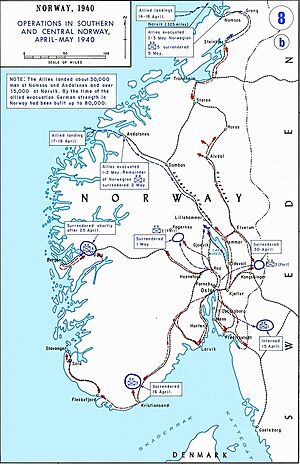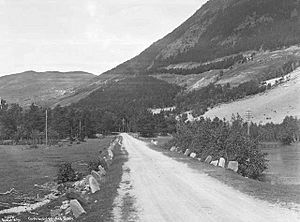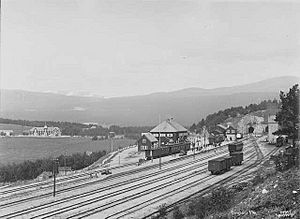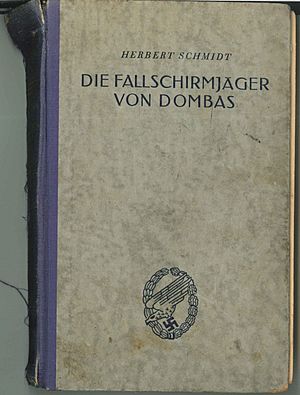Battle of Dombås facts for kids
Quick facts for kids Battle of Dombås |
|||||||
|---|---|---|---|---|---|---|---|
| Part of the Norwegian campaign of the Second World War | |||||||
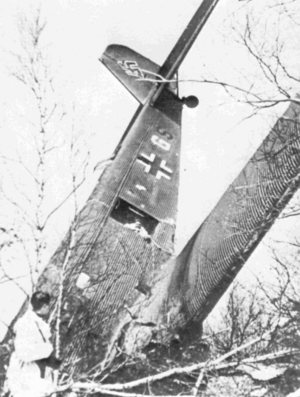 German Junkers Ju 52 downed at Dombås |
|||||||
|
|||||||
| Belligerents | |||||||
| Commanders and leaders | |||||||
| 14–17 April: Ivar Navelsaker 17–19 April: Arne Sunde |
Herbert Schmidt (POW) | ||||||
| Strength | |||||||
| –17 April: Infantry Regiment 11 Infantry Regiment 5 17–19 April: Infantry Regiment 11 Infantry Regiment 5 •Machine gun platoon from NoAAS Jagevingen 19 April: •Rail-mounted howitzer manned by Royal Marines |
7th Flieger Division |
||||||
| Casualties and losses | |||||||
| 20 dead 20 wounded |
During the drop: 15 dead, 20 wounded and 14 injured 7 Junkers Ju 52s shot down, an eighth Ju 52 landed in Sweden and sank through a frozen lake. During the fighting: 6 killed 6 wounded ~150 captured |
||||||
The Battle of Dombås was a fight between Norwegian soldiers and German paratroopers in April 1940. This battle was part of the larger Norwegian campaign during World War II. The Germans dropped paratroopers near Dombås, a key railroad junction, to stop Norwegian and Allied forces. They wanted to block the main train line and road connecting Oslo and Trondheim. For five days, the German paratroopers held their ground, but in the end, the Norwegian forces won.
Contents
Why the Battle Happened
Germany Invades Norway
In April 1940, Nazi Germany invaded Norway. This surprise attack was called Operation Weserübung. The Allies, including Britain, quickly started their own campaign to help Norway. They wanted to stop Germany from taking control of this important country.
Dombås: A Key Location
On April 13, 1940, the German commander in Norway, Nikolaus von Falkenhorst, received orders. He was told to capture Dombås using paratroopers. Dombås is about 336 kilometers (209 miles) north of Oslo. The Germans believed, incorrectly, that Allied troops were landing nearby. Their main goal was to destroy the railroad and block any Allied movement inland. This was especially important for the Gudbrandsdal valley.
Who Fought in the Battle
German Paratroopers
The German force sent to Dombås was the 1st Company of the 7th Flieger Division. This unit was made up of highly trained paratroopers, known as Fallschirmjäger. Their commander was Oberleutnant Herbert Schmidt. The company had 185 soldiers. They carried light weapons and 22 machine guns. This was only the second time in history that paratroopers were used in a battle where the enemy was ready for them.
Norwegian Defenders
The Norwegian forces at Dombås first included the 2nd Battalion of Infantry Regiment 11. Two days after the German attack, more troops arrived. These were from the 1st Company of Infantry Regiment 5. Later, the 2nd Battalion was replaced by the 1st Battalion of Infantry Regiment 11. They also received a machine gun platoon and an anti-aircraft gun. On the last day of the battle, British Royal Marines joined the Norwegians. They brought a large howitzer gun mounted on a train.
Ivar Navelsaker was a Norwegian military officer. He commanded the 2nd Battalion, Infantry Regiment 11, during the Battle of Dombås. He was born in 1893 and became an officer in 1917. Navelsaker was captured by the Germans in 1943 and held as a POW until the end of World War II. After the war, he became a colonel.
The Battle Unfolds
Day One: The Drop
On April 14, at about 5:00 PM, fifteen German Junkers Ju 52 transport planes took off from Oslo. The weather was very bad, with hail, sleet, and low clouds. Even though the officers wanted to wait, the mission had to go ahead. This was because Adolf Hitler himself had ordered it.
When the planes reached Dombås, there were small breaks in the clouds. Most of the paratroopers were able to jump. However, the bad weather scattered them over a wide area. Some landed far from their target.
Fighting the Norwegians
By chance, the German target area was also where the Norwegian 2nd Battalion, Infantry Regiment 11, was based. This battalion had just arrived by train the night before. They were preparing for a planned attack to retake Trondheim. Even though the Norwegians had no anti-aircraft guns, they used their heavy machine guns to shoot at the German planes.
The German planes were surprised. They flew very low, and the Norwegians opened fire with everything they had. Many German planes were hit. Only five out of fifteen Ju 52s made it back to Oslo. Two more landed at another airbase. The other eight planes were shot down or had to make emergency landings. One plane landed in Sweden and sank through a frozen lake. Many paratroopers died in the crashes or were captured.
Oberleutnant Schmidt could only gather 63 of his 185 men. The rest were dead or scattered. With this small group, Schmidt began his mission. They blocked the main road and cut the telephone wires. Schmidt and his men then drove towards Dombås in a captured taxi.
Schmidt is Wounded
Near the farm of Li, the Germans met two trucks full of Norwegian soldiers. After a brief fight, the Norwegians were pushed back. Schmidt was badly wounded in the hip and stomach. Despite his injuries, he stayed in command. The paratroopers stopped their advance on Dombås. Instead, they took up strong defensive positions at the Ulekleiv and Hagevolden farms. Schmidt tried to get supplies from the German air force. He wrote messages in the snow asking for food and ammunition. But no German planes spotted them, so they received no supplies.
Impact of the Attack
The attack on Dombås had an important side effect. It made the Norwegian Central Bank speed up the evacuation of Norway's gold reserves. The gold had been moved from Oslo earlier. When news of the paratroopers spread, the gold was quickly put on a train. It was then taken to Åndalsnes and shipped out by British and Norwegian boats.
King Haakon VII of Norway and Crown Prince Olav were also very close to the drop zone. They had to be quickly escorted away from the area by local volunteers.
Day Two: Norwegian Counterattack
On April 15, the last scattered German paratroopers rejoined Schmidt's force. No more reinforcements arrived for them. In the morning, the paratroopers blew up the railroad line in three places. However, Norwegian workers quickly repaired the damage. Trains were able to pass through the next day.
Norwegian forces gathered to stop the Germans. But they knew very little about the German strength or location. A group of 41 Norwegian soldiers, led by Kaptein Eiliv Austlid, launched an attack. They wanted to clear a path for the Norwegian royal family and government to escape. Austlid and six or seven volunteers charged across a field towards the German positions. They faced heavy machine gun fire. Austlid was shot and killed just meters from the German nest. The attack failed, and many Norwegians were captured.
Day Three: Negotiations and Breakout
On April 16, more Norwegian troops arrived. They attacked the German positions from both the north and the south. The northern attack was supported by mortars and machine guns.
After a short fight, the Germans showed a white flag. They sent a captured Norwegian soldier to demand that the Norwegians surrender. The German commander, Schmidt, likely meant that the prisoners were in danger from the mortar fire. The Norwegians refused. They sent a captured German soldier back, demanding Schmidt's surrender. The Germans also refused.
Germans Break Out
While talks were happening, the German paratroopers planned to move. The Norwegian mortars had changed the battle. The Germans were also running low on ammunition. Schmidt decided they needed a new, more defensible position. He kept the negotiations going to buy time. He hoped that stronger German forces were coming to help him. But in reality, the main German forces were still far to the south.
When negotiations ended, the Norwegians opened fire again. But a sudden snowstorm blinded them. This allowed the Germans to counterattack and escape their encirclement. The Germans pushed back the Norwegian forces in the north. That commander ordered a retreat to Dombås. On the night of April 16/17, Schmidt's paratroopers slipped away and headed south towards Dovre.
Meanwhile, Norwegian units continued to capture scattered Germans. Twenty-two Germans were captured near Lesja, and 23 more at Bottheim train station.
Day Four: New Positions and Renewed Fighting
Early on April 17, the Germans left their positions. They used captured Norwegian machine guns to cover their retreat. The paratroopers formed a column, with wounded soldiers and prisoners in trucks.
At the Landheim road bridge, 25 Norwegians blocked their way. But the Germans quickly pushed them back. The Germans then took up temporary positions at Einbugga road bridge.
Lindse Farms
As daylight came, Schmidt's men searched for a new, strong position. They found it at North and South Lindse Farms. These farms were high on a hillside. They overlooked both the railway line and the main road. North Lindse, with its stone barn, became the main defensive point. South Lindse was used to hold Norwegian prisoners. The farm buildings were quickly reinforced with sandbags. Schmidt, still badly wounded, was carried to Lindse by Norwegian prisoners.
Fighting Continues
On the morning of April 17, fighting started again. Norwegian forces ran into German ambushes at Lindse. A Norwegian Major, Alv Kjøs, was captured. The main Norwegian forces did not realize that all the Germans had moved to Lindse. They spent most of the day reorganizing and getting reinforcements. The 2nd Battalion was replaced by the 1st Battalion. A machine gun platoon also arrived. For most of the day, the Norwegians shelled the empty German positions at Ulekleiv. Only in the evening did they discover where the Germans had moved. That night, a 40 mm anti-aircraft gun arrived to help the Norwegians.
Day Five: Supplies and Final Stand
April 18 was a key day. The Germans at Lindse were surrounded. The Norwegian 1st Battalion was to the north. The 1st Company, Infantry Regiment 5, reinforced by other units, was to the south. The southern company also had the 40 mm anti-aircraft gun for support. Early in the morning, Norwegian soldiers moved into the hills south of Lindse Farm and opened fire.
The German positions were strong, but their ammunition was running very low. It seemed like surrender was the only option. However, help arrived that morning. A German Ju 52 plane air-dropped ammunition, warm clothes, food, and medical supplies. It also gave them a radio frequency to talk to headquarters.
Later, a Norwegian officer asked Schmidt to surrender, but he refused. The Norwegian 40 mm anti-aircraft gun kept firing at Lindse Farms all day. By evening, the Germans had moved into the farmhouses. They knew the Norwegians would not directly bombard the houses because of the prisoners inside.
The Last Day: German Surrender
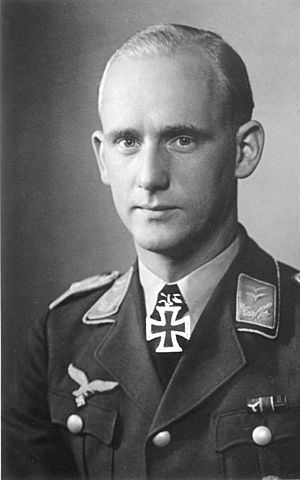
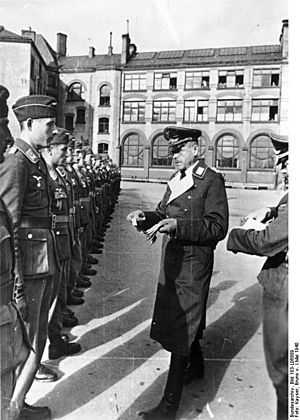
By dawn on April 19, the Germans were completely surrounded by stronger Norwegian troops. During the night, a final reinforcement reached the Norwegians. This was a large howitzer gun mounted on a train, operated by British Royal Marines. The howitzer opened fire at 6:00 AM. Soon after, another German Ju 52 transport plane arrived with supplies. But it turned back after Schmidt radioed that his paratroopers were going to surrender.
Schmidt sent his second-in-command to negotiate. He hoped for good surrender terms. But the Norwegian commander, Major Arne Sunde, demanded an unconditional surrender. Sunde said that if the Germans did not signal their surrender within 10 minutes, the artillery would start firing again. Nine and a half minutes later, at 11:30 AM, the German paratroopers at Lindse fired three signal flares.
Forty-five German paratroopers surrendered at Lindse Farms. Six of them were wounded. After being fed, the captured Germans were sent by train to Dombås.
What Happened After
Casualties and Prisoners
The Germans lost 21 soldiers during the battle. Forty more were wounded or injured. Fifteen Germans died during the initial parachute drop. Six more were killed during the fighting. About 150 Germans were taken as prisoners of war. Seven German transport planes were shot down, and one landed in neutral Sweden.
Norwegian casualties were 20 dead and 20 wounded. Both Norwegian and German wounded soldiers were treated by Norwegian medical staff. They were first taken to a field hospital in Dombås. Then, they were moved to regular hospitals. German soldiers who died were buried by the Norwegian military. Later, their remains were moved to a German war cemetery in Oslo.
Fate of the Prisoners
The captured German soldiers were sent to areas behind the front lines. The badly wounded went to a hospital. The others, about 135 soldiers, were sent to a school in Kristiansund. During German bombing raids on Kristiansund, some prisoners were wounded. They were then moved to a prisoner-of-war camp built at Bruhagen.
The Norwegians planned to question the prisoners and then send them to the United Kingdom. However, as the Norwegian resistance in the south collapsed, the German prisoners were left behind. They were later freed by other German forces. Only three German paratroopers ended up in British hands and were taken to the United Kingdom.
Aftermath for the Germans
Most of the freed German paratroopers volunteered to fight in the isolated Narvik front in northern Norway. Many of the survivors from Dombås died fighting there.
Herbert Schmidt, the German commander at Dombås, received a high military award for his actions. He recovered from his wounds. In 1941, he wrote a book about his experiences in the battle. Schmidt was killed by the French Resistance in 1944.
See also
- List of German military equipment of World War II
- List of Norwegian military equipment of World War II


